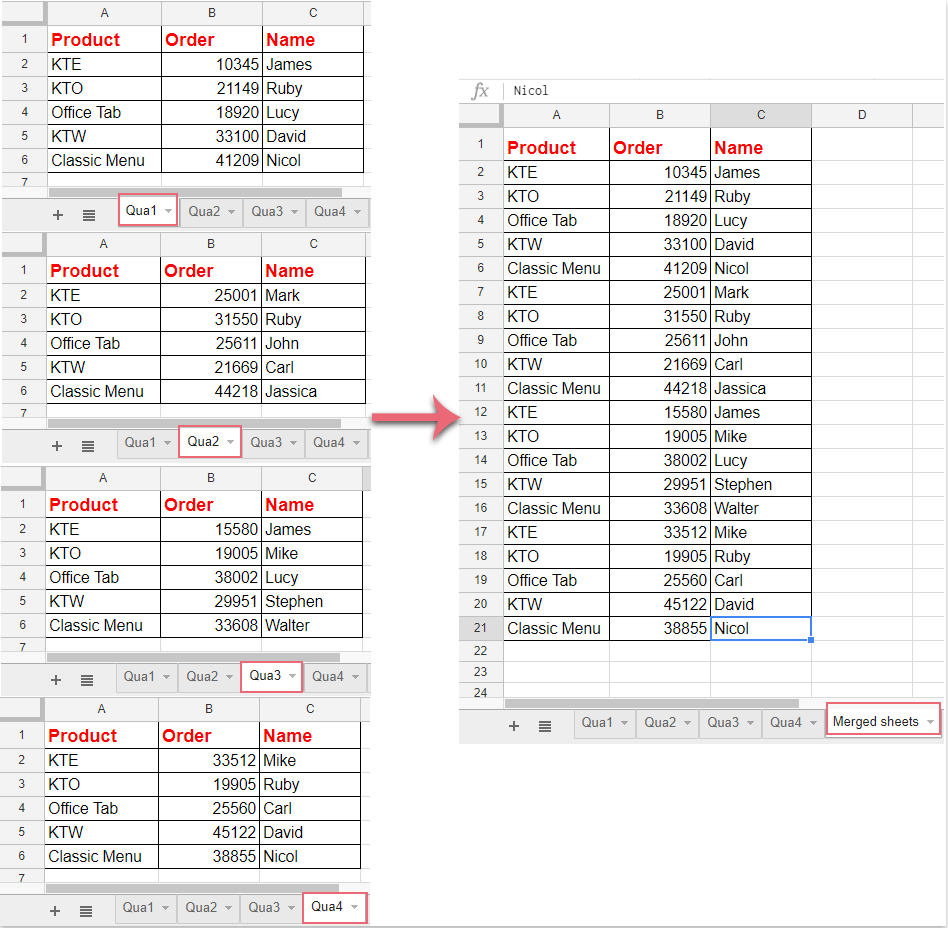Combine Multiple Excel Sheets into One: Easy Guide

If you often work with datasets in Excel, you've likely come across the need to combine data from multiple spreadsheets into one. Whether it's for consolidating monthly reports, integrating customer databases, or merging project data, this task can become time-consuming and tedious if done manually. However, Excel provides various tools to simplify this process, and here, we'll explore these methods in detail to help you combine multiple Excel sheets with ease.
Why Combine Excel Sheets?

Before delving into the how, let’s look at why combining Excel sheets is beneficial:
- Improved Data Analysis: Combining datasets allows for a broader perspective on information, leading to better insights.
- Time Saving: Manual consolidation of data is prone to errors and takes up considerable time; automated methods ensure accuracy and efficiency.
- Data Consistency: Ensures that related data from different sheets follows a uniform format for streamlined analysis.
Using Excel’s Built-in Features

1. Power Query

Power Query is one of Excel’s most powerful tools for data transformation:
- Open a new Excel workbook.
- Go to the Data tab, and select Get Data > From File > From Workbook.
- Choose the Excel file containing the sheets you want to combine.
- In the Navigator window, select each sheet or use the Transform Data option to manage the data further.
- To combine sheets, click on the “Append Queries” button in the Home tab of Power Query Editor.
📝 Note: Ensure the structure of the data in each sheet is uniform to avoid errors in merging.
2. Consolidate

The Consolidate feature is handy for summarizing data from multiple ranges:
- Select the cell where you want the consolidation to appear.
- Go to the Data tab, click Consolidate.
- Choose the function (like sum, average) for consolidation.
- Select each range from the sheets you want to combine using the “Add” button.
- Click OK.
3. Paste Links

This method creates dynamic links to your original data:
- Open all Excel sheets you want to combine.
- Copy the data from one sheet.
- In your new workbook, right-click and select Paste Link (under paste options).
- Repeat for each sheet, ensuring you paste in the correct cells to align the data properly.
Manual Techniques

1. Copy and Paste

While simple, this method is effective for small datasets:
- Open all the sheets you want to combine.
- Select and copy the data from each sheet.
- Paste into your master sheet, ensuring you align the data correctly.
2. VBA for Advanced Users

For larger datasets or regular merging, VBA scripting can automate the process:
- Open the Visual Basic for Applications (VBA) editor by pressing Alt + F11.
- Create a new module and insert the following VBA code to combine sheets:
Sub CombineSheets()
Dim ws As Worksheet
Dim mainSheet As Worksheet
Set mainSheet = ThisWorkbook.Sheets(1) ‘Assuming the first sheet is the master sheet
For Each ws In ThisWorkbook.Sheets
If ws.Name <> mainSheet.Name Then
ws.UsedRange.Copy mainSheet.Cells(mainSheet.Rows.Count, 1).End(xlUp).Offset(1, 0)
End If
Next ws
End Sub
Run this macro to automatically combine all sheets into the first one.
Third-Party Tools

Some third-party software can also be used for more complex merging tasks:
- Excel PowerTools: This suite of tools offers advanced features for Excel data management.
- Ablebits Ultimate Suite: Provides easy solutions for merging and consolidating Excel data.
🛠️ Note: Third-party tools often require a purchase or subscription.
Best Practices for Data Merging

- Ensure Data Uniformity: Sheets should have similar headers and data formats to avoid errors.
- Back Up Data: Always work with copies to prevent data loss.
- Check for Duplicates: Use Excel’s remove duplicates feature after combining to ensure data integrity.
By integrating these techniques into your workflow, you can streamline your data consolidation process, saving time and reducing the risk of errors. Here are a few key takeaways:
- Automation with tools like Power Query, VBA, or third-party software can save significant time.
- Regular Backups protect against data loss during complex operations.
- Data Consistency and formatting checks are crucial for merging accuracy.
Let’s now address some common questions you might have when combining Excel sheets:
What should I do if my Excel sheets have different structures?

+
If the sheets have different structures, consider standardizing them manually or using VBA scripts to automate the process. Align headers or use conditional formatting to visually confirm structure alignment before merging.
Can I combine data from Excel files stored in different locations?

+
Yes, you can use Power Query to connect to various file locations or use VBA to open different workbooks and copy data into your master workbook.
How do I handle large datasets when merging?

+
For large datasets, consider using Power Query for its optimization features or VBA for automated, step-by-step merging to manage memory and processing constraints.